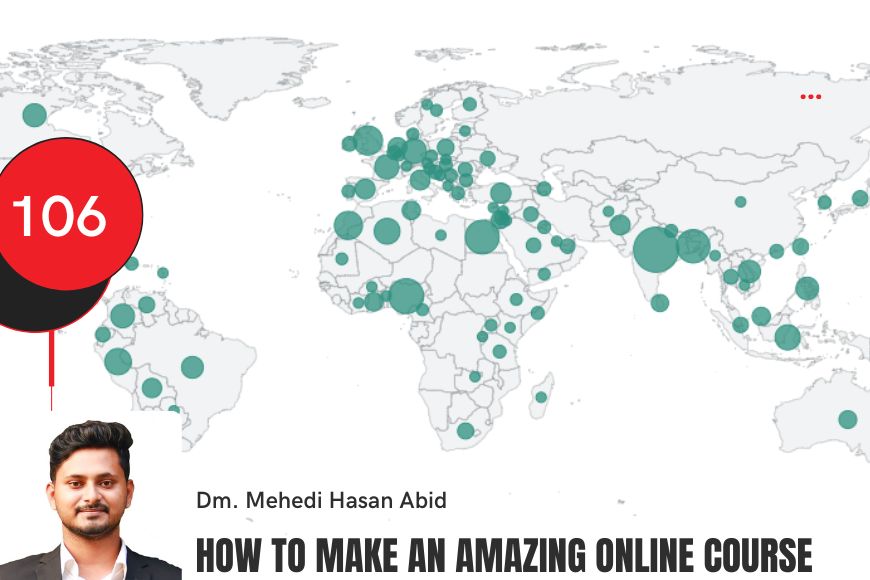
A Masterclass in Online Teaching: A Step-by-Step Guide
From passionate learner to global instructor, DM. Mehedi Hasan Abid embodies the transformative power of online education. With extensive experience on platforms like Udemy and Skillshare, reaching students in over 106 countries, he’s not just a trainer; he’s a living example of how online teaching can amplify your impact and revolutionize traditional learning models.
Are you a university faculty member, educator, content creator, or passionate learner looking to explore the exciting world of online education? This blog post, inspired by Abid’s insightful training session, equips you with the knowledge and tools to create compelling online courses, empowering students worldwide.
Table of Contents
- Building Your Online Course: A Clear Roadmap
- Interactive Lessons: Ignite Engagement
- Course Structure: Building the Foundation
- Necessary Components: Tools and Resources
- Instructor Profile: Establishing Credibility
- Recording and Creating Content
- Editing and Customization
- Captioning for Accessibility
- Enhancing Engagement with B-Roll Footage
- Exporting and Final Touches
- The Future of Online Teaching
In the fast-evolving landscape of education, online teaching has become a necessity, offering educators a global platform to impart knowledge. Recently, I conducted a training session for faculty members at a university, focusing on utilizing efficient tools for creating engaging online courses. The experience was both enlightening and transformative, prompting me to share the insights gained during the session.
Introduction
The journey began with exploring the inner interface of a user-friendly tool—Clipchamp. To emphasize its accessibility, I highlighted that all one needs is a Microsoft account. This platform provides a seamless blend of user personal and educational domains, making it versatile for any user.
Forget replicating entire traditional courses online. Abid advocates for a laser-focused approach, creating shorter courses that delve deep into specific topics. This not only caters to diverse learning styles but also allows for a more immersive and focused learning experience. Think of it as offering specialized workshops within your broader area of expertise.
Building Your Online Course: A Clear Roadmap
Crafting an engaging online course requires a solid foundation. Abid lays out a straightforward structure to guide you:
- Course Information: Craft a captivating title, and a detailed course description, including course objective, and target audiences.
- Video Materials: Design engaging, interactive lessons with clear objectives. Remember, variety is key! Utilize different presentation styles, include visual aids, and encourage learner participation.
- Promotional Content: Hook potential students with your passion and expertise. Showcase the benefits of your course and include a compelling call to action that motivates them to enroll.
Interactive Lessons: Ignite Engagement
Captivating your audience is crucial. Abid explores tools like Microsoft 365 and Clipchamp to help you design visually appealing and interactive content. Here are some key takeaways:
- Connect with your learners: Show your face and personality to create a more personal connection.
- Embrace visual storytelling: Utilize transitions, text overlays, and background videos to keep your audience engaged.
- Enrich your content: Incorporate free resources like images and videos to enhance understanding and provide further context.
Course Structure: Building the Foundation
In designing an online course, a well-thought-out structure forms the backbone. The session emphasized the importance of:
- Clear Learning Objectives: Define specific, measurable objectives to guide both instructors and learners.
- Module Breakdown: Organize content into cohesive modules, easing comprehension and progression.
- Sequential Learning Paths: Design a logical flow of lessons, ensuring a progressive learning journey.
Necessary Components: Tools and Resources
An effective online course necessitates the integration of various components:
- Clipchamp as the Hub: Utilize a user-friendly platform like Clipchamp for seamless content creation.
- Instructor Webcam Presence: Emphasize the significance of showing the instructor’s face for enhanced learner connection.
- Editing Tools: Demonstrate the editing process to refine recorded content, emphasizing the importance of intros and outros.
- Captioning for Accessibility: Explore AI-driven captioning tools for an inclusive learning environment.
- B-Roll Footage: Enhance engagement by integrating short, relevant videos, sourced from platforms like pexels.com.
Instructor Profile: Establishing Credibility
Crafting a compelling instructor profile is pivotal for student engagement:
- Introduction Video: Include a brief introduction video, providing insights into the instructor’s background and passion for the subject.
- Professional Credentials: Highlight relevant qualifications, experience, and achievements to establish credibility.
- Communication Style: Emphasize the importance of a clear and engaging communication style, fostering a connection with learners.
Pedagogy of Teaching Online: Strategies for Success
A solid pedagogical approach is critical for effective online teaching:
- Interactive Elements: Incorporate interactive elements such as quizzes, discussions, and collaborative projects.
- Assessment Strategies: Discuss various assessment methods tailored to the online environment, ensuring fair evaluation.
- Continuous Engagement: Advocate for continuous engagement through regular communication, feedback, and Q&A sessions.
- Adaptability: Encourage instructors to adapt to the online environment, fostering flexibility in response to learner needs.
Recording and Creating Content
The core feature of Clipchamp is its ability to record and create engaging content effortlessly. Opting for the “Screen and Camera” option, I demonstrated the importance of showing both the screen and the instructor’s face simultaneously. This dual perspective significantly enhances learner engagement, bridging the gap between traditional and online classrooms.
While acknowledging that showing one’s face is not mandatory for publishing online courses, I emphasized its importance in establishing a connection with students. In an online setting, where interactions are limited, a visible instructor becomes a focal point for students.
Editing and Customization
Moving forward, I delved into the editing process, showcasing how to refine the recorded content. Using the Clipchamp interface, I demonstrated the simple yet powerful features for trimming unnecessary segments, adjusting screen sizes, and adding transitions between different sections.
The typewriter effect for text, coupled with transitions, provided a professional touch to the content. I highlighted the importance of intros and outros, suggesting that they can be sourced from Clipchamp’s extensive content library.
Captioning for Accessibility
Captioning, a crucial element for accessibility, was another feature explored. Clipchamp’s AI-driven captions simplify the process and allow for customization. The ability to change text color and background ensures that captions align with the overall visual theme.
Enhancing Engagement with B-Roll Footage
To make lectures more dynamic, I introduced the concept of B-roll footage. Using free resources from platforms like pexels.com, educators can seamlessly integrate short videos related to the course content. This not only breaks the monotony but also enhances the learning experience.
Exporting and Final Touches

Concluding the training, I guided participants through the exporting process. Opting for 1080p resolution without watermarks ensures a polished final product. I encouraged educators to leverage free resources and highlighted the importance of landscape videos for a more professional look.
The Future of Online Teaching
The session concluded with a reflection on the future of online teaching. I expressed optimism about the potential of online education and the ongoing efforts at Daffodil International University. The revolutionary projects, such as IOU and GoEdu, are set to reshape the education landscape.
Conclusion
As I signed off from the session, the emphasis was on the transformative power of online teaching. The blog post encapsulates the essence of the training, offering educators a step-by-step guide to elevate their online teaching experience. Remember, creating engaging online courses requires dedication and continuous learning. Embrace the journey, leverage the guidance offered by experts like Abid, and empower students worldwide with your unique knowledge and passion. The future of education is now, and you are at the forefront!
Frequently Asked Questions
How important is it to incorporate a webcam presence in an online course?
Answer: Webcam presence in an online course is crucial for establishing a personal connection with learners. It adds a human touch, making the instructor more relatable, which can significantly enhance engagement and overall learning experience.
Can I use paid videos for B-Roll Footage in my online course, or are there copyright-free alternatives?
Answer: While paid videos can be used, it’s advisable to opt for copyright-free alternatives to avoid legal complications. Platforms like pexels.com offer a plethora of free videos that can be seamlessly integrated into your course, enhancing its quality without any copyright concerns.
What elements should be highlighted in an instructor profile to build credibility?
Answer: An effective instructor profile should include an introduction video, showcasing the instructor’s passion for the subject. It should also highlight professional credentials, relevant qualifications, and a clear communication style to establish credibility and foster a positive learning environment.
How can instructors ensure continuous engagement in an online course?
Answer: Continuous engagement can be ensured through interactive elements like quizzes, discussions, and collaborative projects. Regular communication, constructive feedback, and Q&A sessions also play a vital role in keeping learners engaged and motivated throughout the course.
Is there a recommended duration for online course videos, and how does it impact the learning experience?
Answer: The recommended duration for online course videos varies but generally falls between 2 to 10 minutes. Shorter durations (2-5 minutes) are ideal for practical content, while longer durations (8-10 minutes) may suit theoretical discussions. Keeping videos concise enhances learner focus and understanding.
Do I need expensive software or equipment to create an online course?
Not necessarily! Abid recommends utilizing free and easily accessible tools like Microsoft 365 and Clipchamp for recording and editing video content. He also shares resources for finding free visuals and other learning materials. You can create high-quality online courses without breaking the bank by focusing on good content and utilizing affordable tools effectively.
How much time should I invest in developing an online course?
The time commitment depends on your course length and desired level of polish. Abid emphasizes creating focused, shorter courses rather than replicating entire traditional classes. His training suggests you could create a basic video lesson within an hour, and with consistent effort, build a comprehensive course within a few months. Remember, quality beats quantity, so tailor your time investment based on your specific goals and resources.
How can I ensure my online course stands out in a crowded market?
Focusing on a specific niche and offering targeted content is key. Abid’s advice on crafting a captivating title, descriptions, and promotional materials helps you attract students interested in your unique expertise. Additionally, incorporating interactive elements and showcasing your personality make your course more engaging and memorable.
I have no experience creating online courses. Is Abid’s approach suitable for beginners?
Absolutely! Abid’s training session and upcoming online course cater to educators of all experience levels. He provides a clear roadmap and practical tools that can be adapted to your specific needs and comfort level. Whether you’re a seasoned instructor or just starting, you’ll find valuable insights and actionable steps to guide your journey.



